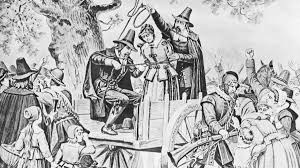Is there anything that says Halloween better than a witch? If not the top, a witch is definitely on the Mount Rushmore of Halloween characters. Throw on a werewolf, Dracula, and Frankenstein’s monster and there you go!
Now I want you to stop, close your eyes, and picture a witch. Once you open your eyes, you probably have an imprint of a green-skinned woman with a black, pointy hat riding a broomstick through the air. You might even hear the far away echo of a cackle. In large part, you have the Wizard of Oz to thank for that imagery.
In 1692, the idea of a witch was very different. It was also no cackling matter in the Massachusetts Bay Colony. Their witches did not have green skin nor did they cackle. They were neighbors and servants. It was thought witches were responsible for the all the plight in life such as disease and famine. There are a lot of great books out there if you want the whole run down (The Witches by Stacy Schiff is one). For those of you into cliff notes, here is a summary.
Puritan girls in 1692 lived a monotonous life. That sometimes led to shenanigans. These shenanigans sometimes took the form of pretending to be possessed and accusing people they didn’t like of being witches. You know standard adolescent stuff. Since the idea of a witch causing all the people’s plight was very real to Salem, it didn’t take much to get these folks riled up.
It only took a couple of girls accusing a couple of women of being witches for the snowball to start. In the end, authorities accuse around 200 people of witchcraft and sentence 20 to death over the course of about a year. Contrary to popular belief, they did not burn any of the 20 at the stake. The colonists left that for their European counterparts. In Salem, 19 suffer hanging while one is pressed.
Were these 20 individuals actually witches? The answer emphatically stands as no. Cotton Mather, the religious authority in Massachusetts at the time, warned people to take spectral evidence (such as dreams and visions) with a grain of salt. Much of the “evidence” was based just on that as well as coerced confessions.
The people realized this was all bogus quickly too. Within a year, the trials and craze were over. Before the turn of the century, Massachusetts Colony declared a day of fasting for the victims and cleared their names of witchcraft. They even provided restitution to the victims’ families.

You may be asking, did the good people of Salem have any common sense? Were there not those who saw reason? Of course there were. And this is where the real villain steps in: fear.
Imagine you are a run-of-the-mill resident of Salem Village at the time. Once the accusations start flying, would you stand up for the accused? Would you not tiptoe around those with the power to put you to death? Could you be tempted to go with the flow out of fear of being cast as a witch yourself even though something is telling you what is going on is wrong?
Remember, to be called a witch was bad news back then. Maybe the closest equivalent today is the label of a terrorist. Only to prove it, accusers needn’t provide hard evidence. All they needed was an easy target and a bone to pick. Or worst of all, a critic.
Were all accusations based on malice with the rest of the people falling in line like sheep? I don’t think it is that simple. That is where hysteria and mob mentality kick in. Keep in mind the people of Salem believed that witches were among them, causing their plight. Further, there wasn’t a legitimate method to prove or disprove the accusations. If you can’t prove you are not a witch, then you could be a witch. Get enough people with this train of thought and you have your hysteria and mob.
We all want to believe we wouldn’t do as the Salemites did. After all, that was over 300 years ago. Is seventy years ago recent enough? In the 1950s, Senator Joseph McCarthy seized on our nation’s fears of communism during the Red Scare in what is often labeled a witch hunt. Or should we even go more recent? Oh, what we can learn from history but all too often don’t!
Back to the Salem Witch Trials. You can learn more about what took place at the Salem Witch Museum. It is a pretty short experience but there is an interesting interactive piece.
A few blocks away is the Salem Witch Trials Memorial. It is a simple memorial which I feel makes it more haunting. Or it could be that it is right next to the Old Burying Point Cemetery, one of the oldest of its kind in the country. Probably more because of the latter.

Make sure to visit Salem on your trip to Boston. In the meantime, for a more humorous take on the Salem Witch Trials, watch this clip from The Simpsons Tree House of Horror VIII:
Thanks for reading. For more spooky history, check out Spirits of the French Quarter: Exploring Haunted History.
